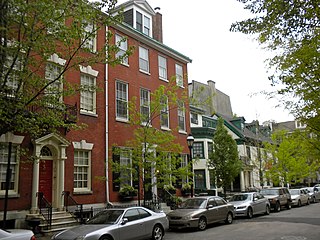
Washington Square West is a neighborhood in downtown, or Center City, Philadelphia, Pennsylvania. The neighborhood roughly corresponds to the area between 7th and Broad Streets and between Chestnut and South Streets, bordering on the Independence Mall tourist area directly northeast, Market East to the north, Old City and Society Hill to the East, Bella Vista directly south, Hawthorne to the southwest, and mid-town Philadelphia and Rittenhouse Square to the west. In addition to being a desirable residential community, it is considered a hip, trendy neighborhood that offers a diverse array of shops, restaurants, and coffee houses. Washington Square West contains many gay-friendly establishments and hosts annual events celebrating LGBT culture in Philadelphia including OutFest. The area takes its name from Washington Square, a historic urban park in the northeastern corner of the neighborhood.

Brewerytown is a neighborhood in the North Philadelphia section of Philadelphia, Pennsylvania, United States. An unofficial region, Brewerytown runs approximately between the Schuylkill River's eastern bank and 25th Street, bounded by Cecil B. Moore Avenue to the north and Parrish Street to the south. Brewerytown got its name because of the numerous breweries that were located along the Schuylkill during the late 19th century and early 20th century. It is now primarily a residential neighborhood, with a growing and active commercial sector along Girard Avenue.

Overbrook Farms is a neighborhood on the western edge of the West Philadelphia section of Philadelphia, Pennsylvania, United States. It is roughly bounded by City Avenue, 58th Street, Woodbine Avenue, and 66th Street at Morris Park. The neighborhood is bisected by Lancaster Avenue and the original Pennsylvania Railroad "main line". Today the rail line is used by both Amtrak passenger service and SEPTA's commuter Paoli/Thorndale Line.

Gravers station is a SEPTA Regional Rail station at 300 East Gravers Lane at Anderson Street, Philadelphia, Pennsylvania. The station building is on the Philadelphia Register of Historic Places and the National Register. It was built in 1872 or 1879 with Furness & Evans as the architect, according to the Philadelphia Architects and Buildings project. On November 7, 1977, it was listed on the National Register of Historic Places, and in 1983 it was acquired by SEPTA's regional rail division.

The University of Pennsylvania Campus Historic District is a historic district on the campus of the University of Pennsylvania, in Philadelphia, Pennsylvania, USA. The university relocated from Center City to West Philadelphia in the 1870s, and its oldest buildings date from that period. The Historic District was added to the National Register of Historic Places on December 28, 1978.
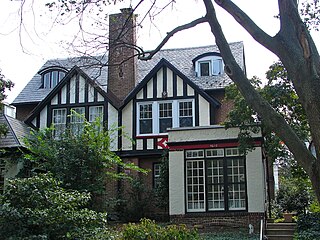
Garden Court is a neighborhood in the West Philadelphia section of Philadelphia, Pennsylvania. It is located west of Spruce Hill, north of Cedar Park, east of Cobbs Creek, and south of Walnut Hill.

Upsala is a historic mansion in Mount Airy, Philadelphia, Pennsylvania, United States. Considered one of the finest extant examples of Federal architecture, the mansion is a contributing property of the Colonial Germantown Historic District and is listed on the National Register of Historic Places and the Philadelphia Register of Historic Places.

The John Coltrane House is a historic house at 1511 North 33rd Street in Philadelphia, Pennsylvania, USA. A National Historic Landmark, it was the home of American saxophonist and jazz pioneer John Coltrane from 1952 until 1958. On his death in 1967 the house passed to his cousin, who sold it in 2004. Efforts for restoration and reuse as a jazz venue are ongoing as of 2013.
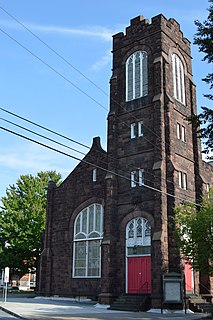
The Mount Pleasant Historic District is a historic district in the western part of the Allison Hill neighborhood of Harrisburg, Pennsylvania. It is located from Market to Brookwood and Allison Hill Bluff to 19th street. It is the oldest section of Allison Hill, representing Harrisburg's early development to the east of downtown. It is home to mostly Victorian architecture.

Lemon Hill is a Federal-style mansion in Fairmount Park, Philadelphia, built from 1799 to 1800 by Philadelphia merchant Henry Pratt. The house is named after the citrus fruits that Pratt cultivated on the property in the early 19th century.

The Pennsylvania School for the Deaf is the third-oldest school of its kind in the United States. Its founder, David G. Seixas (1788–1864), was a Philadelphia crockery maker-dealer who became concerned with the plight of impoverished deaf children that he observed on the city's streets. The current school building is listed by the National Register of Historic Places, and two former campuses are similarly recognized.
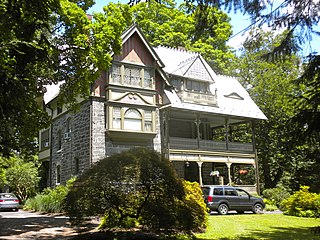
The Chestnut Hill Historic District is a historic area covering all the Chestnut Hill section of Philadelphia, Pennsylvania.
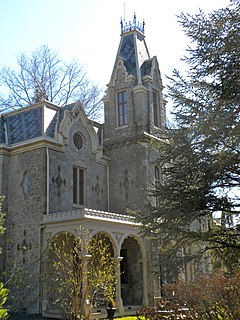
The Ebenezer Maxwell House, operated today as the Ebenezer Maxwell Mansion, is an historic house located in the West Germantown neighborhood of Philadelphia, Pennsylvania.

The Broad Street Historic District is a historic district in Center City, Philadelphia, Pennsylvania. It is bounded roughly by Juniper, Cherry, 15th, and Pine Streets, covering an area about one block on either side of Broad Street.

The Awbury Historic District is a historic area in the East Germantown neighborhood of Philadelphia, Pennsylvania. It encompasses the former summer homes and farms of the extended Cope family, who moved to the area starting in 1849 and the entire Awbury Arboretum, which occupies most of the district's area, as well as adjacent properties developed and occupied by Henry Cope (1793-1865), son and successor to prominent Philadelphia Orthodox Quaker merchant Thomas Pym Cope (1768-1854), his close relatives, and his descendants. The district, which has been described by Philadelphia area historians as "visually distinct from the densely-built urban blocks that surround it on three sides, and from the level, open landscape of the city park to the northwest," features buildings which were designed in the Gothic Revival, Italian Villa, Queen Anne, Tudor Revival, Shingle, and Colonial Revival styles of architecture between 1849 and 1922.

The Newville Historic District is a national historic district which is located in Newville, Cumberland County, Pennsylvania. The district is bordered roughly by Cove Alley, Big Spring Creek, the right-of-way for the Cumberland Valley Railroad, and Washington Street, and encompasses 414 contributing buildings, one contributing site, and two contributing objects in the central business district and surrounding residential areas of Newville.

Washington Avenue Historic District, or Washington Avenue Factory District, is a national historic district located in the Hawthorne and Bella Vista neighborhoods of South Philadelphia, Pennsylvania. It comprises the remaining four blocks of one of the last industrial neighborhoods in Philadelphia, and encompasses eight contributing buildings built between 1889 and 1927:

The Hamburg Historic District is a national historic district located in Hamburg, Berks County, Pennsylvania. The district encompasses 435 contributing buildings in the borough of Hamburg, and is bordered, roughly, by Franklin, Windsor, Walnut, and Second Streets; Quince, Primrose, Peach, and Plum Alleys; and Mill Creek.

The Quakertown Historic District is a historic district which includes most of Quakertown, Pennsylvania. It encompasses, 386 acres and 2,197 contributing buildings.
























